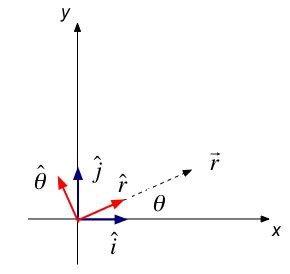
Problems for
Intermediate Methods in Theoretical PhysicsEdward F. Redish
 |
|
A recurring theme in mathematical physics is that while we consider that a physical system exists independent of how we choose to represent it mathematically, that choosing one particular mathematical representation vs another might make things look a lot simpler. Since these representations are different ways of looking at the same thing, you have to be able to go from one to the other by mathematical transformations (in principle -- when you can't, there's often new physics hiding buried in the math and the math is trying to tell you that). Let's try this in a straightforward example: circular motion.
| (a) Consider a vector describing an object's position in a two space:
We want to consider the object moving around the origin in a circle, so it's distance from the origin  is a constant, even though x(t) and y(t) are functions of time. Let's create a new polar coordinate basis, |
 |
(c) Now consider that the particle is moving in the circle determined by the polar equations
where ω is a constant. Construct the vector velocity by differentiating ![]() with
respect to time. Do it in two ways: first by differentiating the expression for
the vector in terms of of the x-y basis and second by differentiating the expression
for the vector in terms of the r-θ basis. Show that the answers you get
are the same.
with
respect to time. Do it in two ways: first by differentiating the expression for
the vector in terms of of the x-y basis and second by differentiating the expression
for the vector in terms of the r-θ basis. Show that the answers you get
are the same.
Last revision 4. November, 2004.